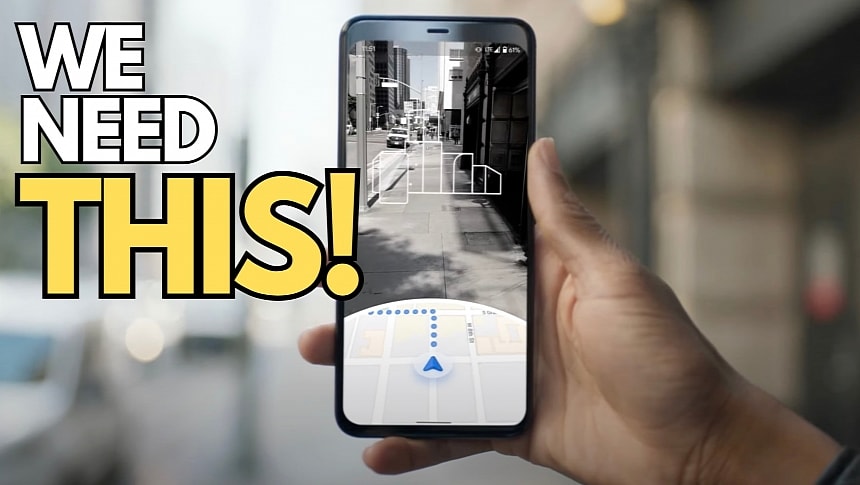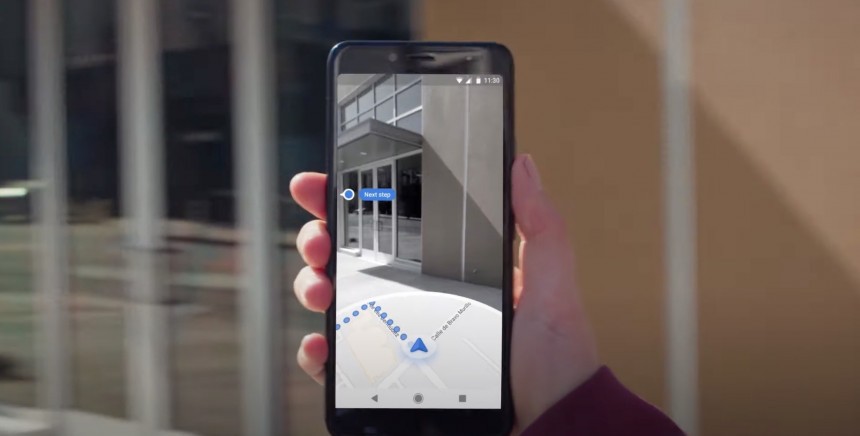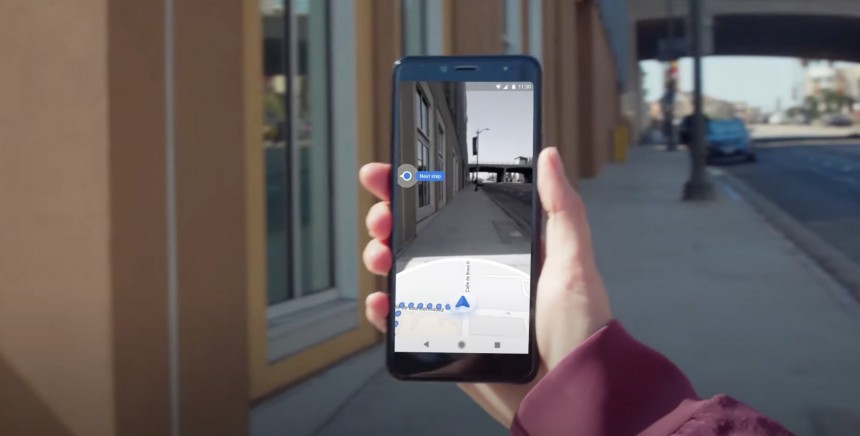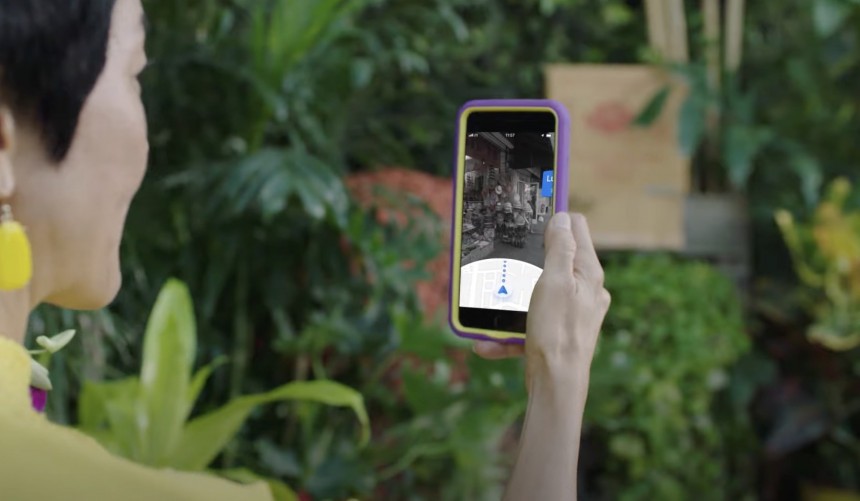Google Maps offers not only the essential feature package for navigation and world exploration but also new-generation capabilities that you won't find elsewhere.
Immersive View for routes is a great example. Built with aerial imagery, street-level photos, 3D models, traffic history data, and weather forecasts, Immersive View for routes generated a highly detailed preview of a configured route, allowing drivers to get familiar with every turn and road section before starting the journey.
Google Maps fuses all data to create a multi-dimensional simulation of the route to explore the route as if you were already on the road.
Google should now gear up for the next big thing in Google Maps: augmented reality for driving navigation.
I recently got the chance to try out a similar implementation from Sygic. The company calls it "Real View Navigation," and I already detailed how it works in a previous story. In just a few words, Sygic's AR-powered navigation uses the phone's camera to scan the road ahead and project turn-by-turn guidance onto real-world imagery.
This means you won't see the next turn, the distance to the destination, and the ETA on the typical map layer or over satellite imagery. The phone's camera films the road ahead and allows the application to display everything on top of what you see when you look ahead.
You can't imagine how useful it is until you take it for a spin. Navigation is significantly more straightforward, as you can always tell which way to go. I've always found navigation apps particularly confusing in complex intersections or large roundabouts where determining the exit you should use is more difficult and takes time you can't afford when you're in motion. With AR-powered navigation, you follow the trail on the road, so it takes a second to take the right exit.
Sygic's implementation highlights the suggested route on top of real-life imagery using a familiar blue line similar to the one you use when standard navigation is enabled.
Google Maps can push this concept to a whole new level.
Google already has the technology to make it happen. Augmented reality is integrated into Live View, a feature that allows users to scan their surroundings when walking with Google Maps running on their mobile devices. Live View uses AR to fetch data on restaurants, landmarks, and other POIs, helping users discover new places around them. It can also offer navigation, so you can walk with your phone and follow a suggested route more conveniently.
Support for driving would be a killer feature. Google could offer AR-powered navigation using the phone's camera on mobile devices but also connect it to onboard cameras in vehicles with Google built-in to scan the road ahead and project live images on the infotainment screen or the instrument cluster. Android Automotive already sports a more advanced Google Maps version thanks to deeper vehicle integration, so AR support should be the next big thing to set the app apart from the rest of the crowd.
However, the version aimed at the masses would still use mobile devices to make AR magic happen. This is the reason Google probably isn't in a hurry to release this feature – I asked around, and it seems the search giant at least considered bringing AR navigation to Google Maps driving mode; my sources couldn't confirm that the feature is in development, but it "was certainly on the table" a few years ago.
Keeping a phone on the dashboard specifically to get AR-powered navigation is a challenge. In my time with Sygic's software, the most difficult thing to do was to find the right angle not only to allow the mobile device to scan the road ahead but also to let me see the screen and the provided navigation instructions clearly. You also need a sturdy phone holder to keep the phone in place, and I believe a model that sticks to the windshield is more useful because the device can collect real-world imagery more easily.
The second big challenge is to make the feature work at night. Phone cameras have improved significantly lately, offering stunning night-time shots, but they're still not at a point where they can produce high-quality long-distance shots in total darkness. A phone camera would struggle to scan the road at night, especially when dealing with incoming traffic that would make it blind.
However, there are ways to deal with these limitations. Google Maps could automatically switch to a standard navigation mode at night and enable the AR mode only during the day. It could also limit the feature to cars with Google built-in, where the search giant could work with carmakers to install special cameras with better performance in low-light conditions.
Google has so far remained tight-lipped on updates for Google Maps in this direction, but considering the company has explored this idea, I don't think we're far from an early testing version.
Google Maps fuses all data to create a multi-dimensional simulation of the route to explore the route as if you were already on the road.
Google should now gear up for the next big thing in Google Maps: augmented reality for driving navigation.
I recently got the chance to try out a similar implementation from Sygic. The company calls it "Real View Navigation," and I already detailed how it works in a previous story. In just a few words, Sygic's AR-powered navigation uses the phone's camera to scan the road ahead and project turn-by-turn guidance onto real-world imagery.
You can't imagine how useful it is until you take it for a spin. Navigation is significantly more straightforward, as you can always tell which way to go. I've always found navigation apps particularly confusing in complex intersections or large roundabouts where determining the exit you should use is more difficult and takes time you can't afford when you're in motion. With AR-powered navigation, you follow the trail on the road, so it takes a second to take the right exit.
Sygic's implementation highlights the suggested route on top of real-life imagery using a familiar blue line similar to the one you use when standard navigation is enabled.
Google Maps can push this concept to a whole new level.
Google already has the technology to make it happen. Augmented reality is integrated into Live View, a feature that allows users to scan their surroundings when walking with Google Maps running on their mobile devices. Live View uses AR to fetch data on restaurants, landmarks, and other POIs, helping users discover new places around them. It can also offer navigation, so you can walk with your phone and follow a suggested route more conveniently.
However, the version aimed at the masses would still use mobile devices to make AR magic happen. This is the reason Google probably isn't in a hurry to release this feature – I asked around, and it seems the search giant at least considered bringing AR navigation to Google Maps driving mode; my sources couldn't confirm that the feature is in development, but it "was certainly on the table" a few years ago.
Keeping a phone on the dashboard specifically to get AR-powered navigation is a challenge. In my time with Sygic's software, the most difficult thing to do was to find the right angle not only to allow the mobile device to scan the road ahead but also to let me see the screen and the provided navigation instructions clearly. You also need a sturdy phone holder to keep the phone in place, and I believe a model that sticks to the windshield is more useful because the device can collect real-world imagery more easily.
However, there are ways to deal with these limitations. Google Maps could automatically switch to a standard navigation mode at night and enable the AR mode only during the day. It could also limit the feature to cars with Google built-in, where the search giant could work with carmakers to install special cameras with better performance in low-light conditions.
Google has so far remained tight-lipped on updates for Google Maps in this direction, but considering the company has explored this idea, I don't think we're far from an early testing version.









